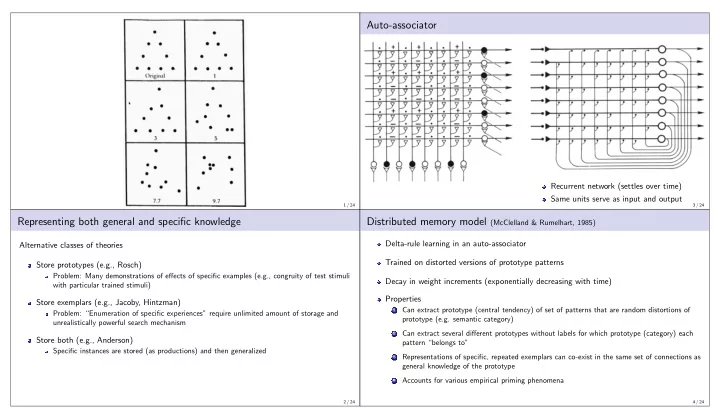

Auto-associator Recurrent network (settles over time) Same units serve as input and output 1 / 24 3 / 24 Representing both general and specific knowledge Distributed memory model (McClelland & Rumelhart, 1985) Delta-rule learning in an auto-associator Alternative classes of theories Trained on distorted versions of prototype patterns Store prototypes (e.g., Rosch) Problem: Many demonstrations of effects of specific examples (e.g., congruity of test stimuli Decay in weight increments (exponentially decreasing with time) with particular trained stimuli) Properties Store exemplars (e.g., Jacoby, Hintzman) Can extract prototype (central tendency) of set of patterns that are random distortions of 1 Problem: “Enumeration of specific experiences” require unlimited amount of storage and prototype (e.g. semantic category) unrealistically powerful search mechanism Can extract several different prototypes without labels for which prototype (category) each 2 Store both (e.g., Anderson) pattern “belongs to” Specific instances are stored (as productions) and then generalized Representations of specific, repeated exemplars can co-exist in the same set of connections as 3 general knowledge of the prototype Accounts for various empirical priming phenomena 4 2 / 24 4 / 24
Prototype extraction Multiple prototypes ”dog” as prototype ”dog” vs. ”cat” vs. ”bagel” 24 units: 16 general + 8 specific (name) correlation(dog,cat) = 0.5 50 training patterns with p=0.2 distortion of general information bagel orthogonal to dog and cat weight changes decay to 5% 16 general units + 8 specific (name) units weights capture correlational structure of prototype 50 training patterns for each prototype, all units distorted with p=0.1 5 / 24 7 / 24 Multiple prototypes 6 / 24 8 / 24
Multiple prototypes (no labels) Co-existence of prototype and exemplars 9 / 24 11 / 24 Co-existence of prototype and exemplars Priming: Effect of familiarity 10 training cycles on distortions (p=0.1) of 8 prototypes ”dog” prototype with Fido and Rover as specific dogs new distortions of familiar prototype produce stronger response than unfamiliar pattern 3 names: ”dog”, ”Fido”, ”Rover” other dogs: distortion p=0.2 of dog prototype 50 training trials of each 50 for Fido and Rover each 50 for distortions of dog 10 / 24 12 / 24
Priming: Effect of similarity Priming: Effect of training primes: execute weight changes for pattern with no decay identical > similar > unrelated 13 / 24 15 / 24 Priming: Effect of novelty on repetition priming Trade-off of specific vs. general representation Formation of prototype depends on collective similarity of exemplars Similarity (proximity) to a specific trained pattern is a strong determiner of perceptual performance But effects of specific exemplars break down when they are closer to the prototype Then response to prototype is stronger than to any trained exemplar (even though it is ”unfamiliar”) Intuition : separate vs. converging gaussians Training lowers energy (raises goodness) of trained pattern and those similar to it Effects accumulate/combine if they are overlapping (over the same units) [ prototype-like ] Effects remain independent if they are non-overlapping [ exemplar-like ] 14 / 24 16 / 24
Similarity and generalization Chimps like onions Weights build up from all active input units due to correlation with output 17 / 24 19 / 24 Do chimps like onions? All primates like onions Input is distributed representation of entity (chimp) “General” weights build up due to correlations Output is observed features (just considering “likes onions” here) “Specific” weights don’t—no correlation because inputs vary when output is active Weights are updated with Hebbian learning 18 / 24 20 / 24
Other primates don’t like onions Other animals don’t like onions (but primates do) No correlation for “specific” weights because inputs vary “Specific” weights build up due to correlations No correlation for “more general” weights because output varies No correlation for “general” weights because input is stable but output varies Only intermediate “general” weights build up due to correlations 21 / 24 23 / 24 All animals like onions Learning new concepts Localist: must create new unit and its connections or find such a pre-existing unit Learning of concept is discrete event Distributed: make new pattern stable by weight adjustment Concept emerges gradually over time Microfeatures (units) constitute language for describing concepts 2 n potential concepts for n units (subject to similarity constraints) How is an appropriate pattern chosen for a new concept? Pattern requiring minimal weight changes to become stable and have the required effects Should incorporate general/specific relationships as just described Learned in the context of particular tasks/behavior Only the “more general” units are correlated with the output Requires algorithms for training internal ( “hidden” ) units 22 / 24 24 / 24
Recommend
More recommend